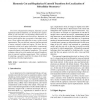Free Online Productivity Tools
i2Speak
i2Symbol
i2OCR
iTex2Img
iWeb2Print
iWeb2Shot
i2Type
iPdf2Split
iPdf2Merge
i2Bopomofo
i2Arabic
i2Style
i2Image
i2PDF
iLatex2Rtf
Sci2ools
ICPR
2002
IEEE
2002
IEEE
Harmonic Cut and Regularized Centroid Transform for Localization of Subcellular Structures
Two novel computational techniques, harmonic cut and regularized centroid transform, are developed for segmentation of cells and their corresponding substructures observed with an epi-fluorescence microscope. Harmonic cut detects small regions that correspond to subcellular structures. These regions also affect the accuracy of the overall segmentation. They are detected, removed, and interpolated to ensure continuity within each region. We show that interpolation within each region (subcellular compartment) is equivalent to solving the Laplace equation on a multiconnected domain with irregular boundaries. The second technique, referred to as the regularized centroid transform, aims to separate touching compartments. This is achieved by adopting a quadratic model for the shape of the object and relaxing it for final segmentation.
| Added | 14 Jul 2010 |
| Updated | 14 Jul 2010 |
| Type | Conference |
| Year | 2002 |
| Where | ICPR |
| Authors | Qing Yang, Bahram Parvin |
Comments (0)

